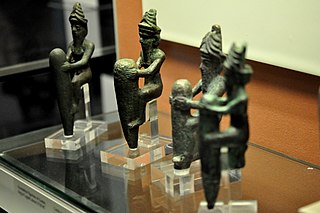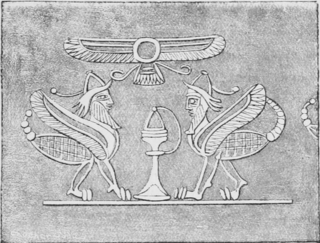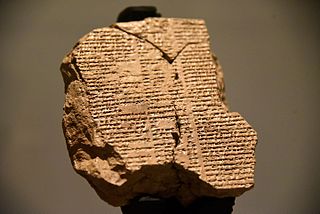
Enlil, later known as Elil, is an ancient Mesopotamian god associated with wind, air, earth, and storms. He is first attested as the chief deity of the Sumerian pantheon, but he was later worshipped by the Akkadians, Babylonians, Assyrians, and Hurrians. Enlil's primary center of worship was the Ekur temple in the city of Nippur, which was believed to have been built by Enlil himself and was regarded as the "mooring-rope" of heaven and earth. He is also sometimes referred to in Sumerian texts as Nunamnir. According to one Sumerian hymn, Enlil himself was so holy that not even the other gods could look upon him. Enlil rose to prominence during the twenty-fourth century BC with the rise of Nippur. His cult fell into decline after Nippur was sacked by the Elamites in 1230 BC and he was eventually supplanted as the chief god of the Mesopotamian pantheon by the Babylonian national god Marduk.

Gilgamesh was a hero in ancient Mesopotamian mythology and the protagonist of the Epic of Gilgamesh, an epic poem written in Akkadian during the late 2nd millennium BC. He was possibly a historical king of the Sumerian city-state of Uruk, who was posthumously deified. His rule probably would have taken place sometime in the beginning of the Early Dynastic Period, c. 2900 – 2350 BC, though he became a major figure in Sumerian legend during the Third Dynasty of Ur.

Inanna is the ancient Mesopotamian goddess of love, war, and fertility. She is also associated with beauty, sex, divine law, and political power. Originally worshiped in Sumer, she was known by the Akkadian Empire, Babylonians, and Assyrians as Ishtar. Her primary title was "the Queen of Heaven".

In Mesopotamian mythology, Ereshkigal was the goddess of Kur, the land of the dead or underworld in Sumerian mythology. In later myths, she was said to rule Irkalla alongside her husband Nergal. Sometimes her name is given as Irkalla, similar to the way the name Hades was used in Greek mythology for both the underworld and its ruler, and sometimes it is given as Ninkigal, lit. "Lady of the Great Earth".

The Anunnaki are a group of deities of the ancient Sumerians, Akkadians, Assyrians and Babylonians. In the earliest Sumerian writings about them, which come from the Post-Akkadian period, the Anunnaki are deities in the pantheon, descendants of An and Ki, the god of the heavens and the goddess of earth, and their primary function was to decree the fates of humanity. They should not be confused with the Apkallu.

Enūma Eliš Babylonian creation myth. It was recovered by English archaeologist Austen Henry Layard in 1849 in the ruined Library of Ashurbanipal at Nineveh. A form of the myth was first published by English Assyriologist George Smith in 1876; active research and further excavations led to near completion of the texts and improved translation.

Anzû, also known as dZû and Imdugud, is a monster in several Mesopotamian religions. He was conceived by the pure waters of the Apsu and the wide Earth, or as son of Siris. Anzû was depicted as a massive bird who can breathe fire and water, although Anzû is alternately depicted as a lion-headed eagle.
Ancient Semitic religion encompasses the polytheistic religions of the Semitic peoples from the ancient Near East and Northeast Africa. Since the term Semitic itself represents a rough category when referring to cultures, as opposed to languages, the definitive bounds of the term "ancient Semitic religion" are only approximate.
The Labbu Myth, “The Slaying of Labbu”, or possibly: the Kalbu Myth – depending on the reading of the first character in the antagonist's name ; is an ancient Mesopotamian creation epic with its origin no later than the Old Babylonian period. It is a folktale possibly of the Diyala region, since the later version seems to feature the god Tišpak as its protagonist and may be an allegory representing his replacement of the chthonic serpent-god Ninazu at the top of the pantheon of the city of Eshnunna. This part is played by Nergal in the earlier version. It was possibly a precursor of the Enûma Eliš, where Labbu – meaning "Raging One" or "lion", was the prototype of Tiamat and of the Canaanite tale of Baal fighting Yamm.

Alexander Heidel (1907–1955) was an Assyriologist and biblical scholar, and a Member of the Research Staff of the Oriental Institute of the University of Chicago.

Scorpion men are featured in several Akkadian language myths, including the Enûma Elish and the Babylonian version of the Epic of Gilgamesh. The Scorpion Men are described as having the head, torso, and arms of a man and the body of a scorpion.
Ki was the earth goddess in Sumerian religion, chief consort of the sky god An. In some legends Ki and An were brother and sister, being the offspring of Anshar and Kishar, earlier personifications of the heavens and earth.
Ilawela is, in Sumerian and Akkadian mythology, a minor god of intelligence. In the Atra-Hasis Epic he was sacrificed by the great gods and his blood was used in the creation of mankind:
Ilawela who had intelligence,
They slaughtered in their assembly.
Nintu mixed clay
With his flesh and blood.
They heard the drumbeat forever after.
A ghost came into existence from the god’s flesh,
And she (Nintu) proclaimed it as his living sign.
The ghost existed so as not to forget. […]
You have slaughtered a god together with his intelligence.
I have relieved you of your hard work.
I have imposed your load on man.

Dumuzid or Dumuzi or Tammuz, known to the Sumerians as Dumuzid the Shepherd and to the Canaanites as Adon, is an ancient Mesopotamian and Levantine deity associated with agriculture and shepherds, who was also the first and primary consort of the goddess Inanna. In Sumerian mythology, Dumuzid's sister was Geshtinanna, the goddess of agriculture, fertility, and dream interpretation. In the Sumerian King List, Dumuzid is listed as an antediluvian king of the city of Bad-tibira and also an early king of the city of Uruk.

Anu or Anum, originally An, was the divine personification of the sky, king of the gods, and ancestor of many of the deities in ancient Mesopotamian religion. He was regarded as a source of both divine and human kingship, and opens the enumerations of deities in many Mesopotamian texts. At the same time, his role was largely passive, and he was not commonly worshipped. It is sometimes proposed that the Eanna temple located in Uruk originally belonged to him, rather than Inanna, but while he is well attested as one of its divine inhabitants, there is no evidence that the main deity of the temple ever changed, and Inanna was already associated with it in the earliest sources. After it declined, a new theological system developed in the same city under Seleucid rule, resulting in Anu being redefined as an active deity. As a result he was actively worshipped by inhabitants of the city in the final centuries of the history of ancient Mesopotamia.
There are many references to ghosts in ancient Mesopotamian religion – the religions of Sumer, Babylon, Assyria and other early states in Mesopotamia. Traces of these beliefs survive in the later Abrahamic religions that came to dominate the region.

The creation of life from clay is a miraculous birth theme that appears throughout world religions and mythologies.
Stephanie Mary Dalley FSA is a British Assyriologist and scholar of the Ancient Near East. She has retired as a teaching Fellow from the Oriental Institute, Oxford. She is known for her publications of cuneiform texts and her investigation into the Hanging Gardens of Babylon, and her proposal that it was situated in Nineveh, and constructed during Sennacherib's rule.

Mesopotamian mythology refers to the myths, religious texts, and other literature that comes from the region of ancient Mesopotamia which is a historical region of Western Asia, situated within the Tigris–Euphrates river system that occupies the area of present-day Iraq. In particular the societies of Sumer, Akkad, and Assyria, all of which existed shortly after 3000 BCE and were mostly gone by 400 CE. These works were primarily preserved on stone or clay tablets and were written in cuneiform by scribes. Several lengthy pieces have survived erosion and time, some of which are considered the oldest stories in the world, and have given historians insight into Mesopotamian ideology and cosmology.












